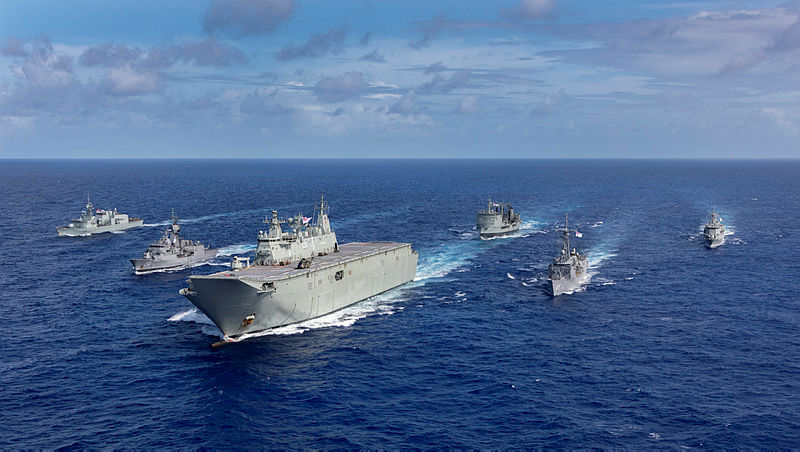The relationship between industry and Navy serves a critical role in supporting the introduction of future capabilities, while keeping the existing fleet at sea and mission capable in defence of the nation and its interests, Commander of the Australian Fleet, Rear Admiral Jonathan Mead has told Defence Connect.
As Australia continues its $90 billion naval shipbuilding program, collaboration between Defence and industry will play a critical role throughout the manufacturing, maintenance and sustainment cycles of Navy's future frigates, submarines and offshore patrol vessels.
This next phase of the warship and submarine capability acquisition marks the turning point for both Navy as an operational force and industry as a long-term partner, invested in the sovereign capability of Australia's defence capabilities.
For Commander of the Australian Fleet, Rear Admiral Jonathan Mead, the recent program milestones mark major progress towards meeting the capabilities outlined in the 2016 Defence White Paper, while enhancing industry involvement in supporting the development of sovereign industrial capability.
"The announcements made in the last week really are the culmination of many years of hard work on the OPV, future submarines and future frigate programs, and it is great to see all the infrastructure breaking ground ahead of the building process," RADM Mead told Defence Connect.
The 2016 Defence White Paper (DWP) and its focus on supporting industry through the sovereign industry capability and naval shipbuilding plans sought to respond to increased regional tensions and forge a path forward, following nearly two decades of 'valleys of death', cost and delivery overruns and shrinking defence budgets.
"The 2016 White Paper forced a major reset for us in Defence. It took us down the process of being more efficient throughout the procurement process, from contracting through to maintenance and sustainment," RADM Mead said.
Learning lessons from the past
Much is known about the challenges faced throughout the procurement and maintenance cycles of key navy projects like the Collins Class submarines and the Hobart Class guided missile destroyers.
Design and manufacturing delays stemming from a variety of design and contractual issues throughout the early stages of the programs, combined with changing capability requirements, hindered the successful delivery of the key platforms, providing insights for major naval capability acquisition programs moving forward.
RADM Mead told Defence Connect, "One of the greatest lessons we learned through the Collins and Hobart programs was the necessity of combining the designer and shipbuilder, now sometimes they're the one entity, but getting the integrated collaboration early on is critical to the success of these major projects."
Adding to this, RADM Mead was quick to identify the importance of clearly defined operational capabilities for major naval assets, like the future submarines and guided missile frigates, to minimise additional cost and delivery overruns.
Improving the relationships
RADM Mead was quick to recognise that the relationships between Defence, Navy and industry had not always been as collaborative as they currently are, particularly following the challenges throughout the Collins and Hobart programs, but identified that while much had improved between the organisations there was always room for improvement.
Mead credited the reformation of DMO into CASG as providing a "quantum leap" in the level of industry and Navy engagement and collaboration and was critical to ensuring the improved relations currently enjoyed.
"What I have noticed with the businesses and the companies that succeed is that they keep the lines of communication open and they're willing to take criticism from us when it is warranted. Navy has to be open to the model too, what we expect of industry we must model ourselves," RADM Mead told Defence Connect.
For RADM Mead, the importance of these relationships goes beyond the initial procurement phase and extends to the through-life support for these key platforms, as industry plays an important part in keeping the Navy's ships and submarines at sea, operational and mission capable over their life cycle.
The growing importance of Australian SMEs throughout the supply chain also plays a critical role in supporting the Navy's mission of being "Battle Ready and Deployed", and RADM Mead identified that both Navy and Defence had made great strides in supporting Australian SMEs become integrated within large defence projects, particularly major naval projects like SEA 1000 and SEA 5000.
RADM Mead told Defence Connect, "The first principals review saw us shift from having the same contracting process for a project worth $10 million and a project worth $50 billion, to a more flexible approach. We found that it stifled industry and highlighted the need for us to work more closely with industry to keep our existing and future vessels capable throughout their life cycles."
As he identified, when 20-30 per cent of a project cost is in the initial procurement and the remaining 70-80 per cent is spread across the maintenance and sustainment cycles, robust, collaborative relationships with industry are critical to keeping Navy capable throughout the coming decades.








